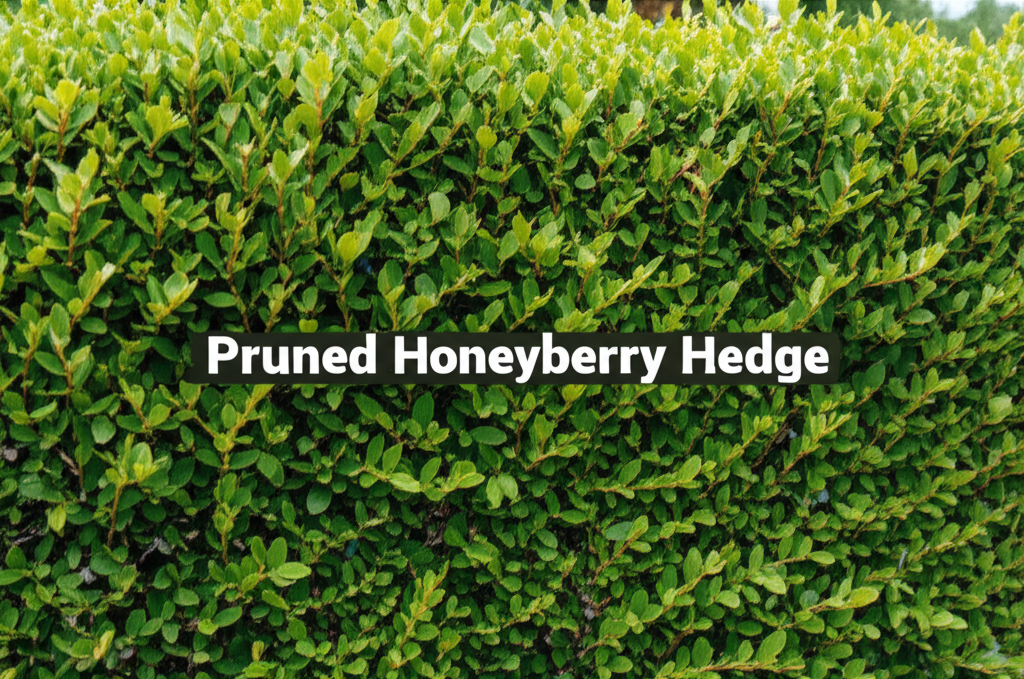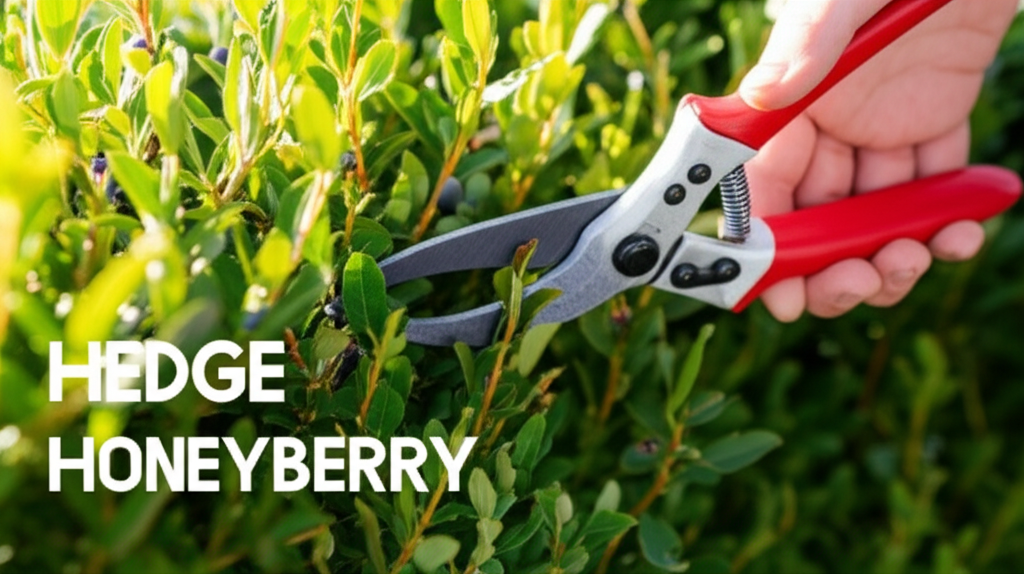The Allure of Honeyberry Hedges
Honeyberry shrubs, scientifically known as Haskap or Lonicera caerulea, are increasingly gaining popularity not just for their delicious, antioxidant-rich berries, but also for their potential as attractive and functional ornamental hedges. Unlike traditional hedging plants that might require meticulous shaping, honeyberry shrubs offer a more forgiving and rewarding experience, combining ornamental appeal with productive fruit-bearing. Their graceful, arching branches, attractive foliage, and delicate spring flowers contribute to a naturalistic beauty that can transform any garden landscape. This article delves into the art and science of honeyberry shrub pruning, specifically focusing on techniques to cultivate them into aesthetically pleasing ornamental hedges.
Understanding Honeyberry Growth Habits
Before embarking on pruning, understanding the natural growth habit of honeyberry shrubs is crucial. Honeyberries are typically deciduous shrubs that grow to a moderate size, with many varieties reaching heights and widths of 4-6 feet. They possess an upright, yet often arching, branching structure. New growth typically emerges from the base and extends outwards and upwards. The plant produces flowers and fruits on the previous year’s wood. This knowledge informs how and when pruning cuts are most effective for shaping and maintaining a dense, attractive hedge.
Pruning Goals for Ornamental Honeyberry Hedges
The primary goals when pruning honeyberry shrubs for ornamental hedges are:
- Shape and Structure: To create a defined and aesthetically pleasing hedge form.
- Density: To encourage bushier growth and a fuller appearance.
- Health and Vigor: To remove dead, damaged, or diseased wood, promoting overall plant health.
- Aesthetics: To enhance the visual appeal through graceful lines and a well-maintained appearance.
- Fruit Production (Optional but Beneficial): While the focus is ornamental, proper pruning can also support healthy fruit development.
Essential Pruning Tools and Techniques

Having the right tools and understanding basic pruning techniques are fundamental for success.
Essential Pruning Tools
- Bypass Pruners: For clean cuts on smaller branches (up to ¾ inch diameter).
- Loppers: For branches between ¾ inch and 1.5 inches in diameter.
- Pruning Saw: For larger, older branches.
- Hedge Shears: For shaping and maintaining the overall hedge line, especially for younger plants or light trimming.
- Gloves: To protect your hands.
Key Pruning Techniques
- Thinning Cuts: Removing an entire branch back to its origin, either at the base of the shrub or a larger branch. This encourages light penetration and air circulation.
- Heading Cuts: Cutting a branch back to a bud or a smaller lateral branch. This promotes branching and can encourage a denser growth habit.
- Removing Dead, Damaged, or Diseased Wood: This is a crucial step that should be performed at any time of year. Cut back to healthy wood.
- Rubbing and Crossing Branches: Remove branches that rub against each other, as this can cause damage and invite disease.
When to Prune Honeyberry Shrubs for Ornamental Hedges
The timing of pruning is critical to achieve the desired aesthetic and to avoid negatively impacting flower or fruit production.
The Ideal Pruning Seasons
Honeyberry shrubs are best pruned during their dormant season, typically in late winter or very early spring before new growth begins. This allows for clear visibility of the branch structure without the foliage and minimizes stress on the plant.
Post-Bloom Trimming for Shaping
While the primary pruning should be dormant, light shaping can be done immediately after the fruiting period in mid-summer. This is particularly useful for controlling the size and spread of the hedge and for removing any errant branches that disrupt the desired shape. However, be mindful that significant pruning after flowering may reduce the following year’s fruit yield, as honeyberries fruit on old wood. For purely ornamental hedges where fruit is secondary, this mid-summer trim can be more aggressive.
Pruning Strategies for Different Hedge Stages
The approach to pruning will vary depending on whether you are establishing a new hedge or maintaining an established one.
Establishing a New Honeyberry Hedge
When planting new honeyberry shrubs for a hedge, the initial focus is on encouraging a strong root system and a robust central framework.
Year 1-2: Foundation Building
- Planting: Space your honeyberry plants according to their mature size to allow for optimal growth and development without overcrowding.
- Initial Trim: After planting, prune back about one-third of the top growth. This encourages the plant to put energy into root development rather than top growth.
- Shape Gently: Focus on removing any weak or crossing branches. Allow the plant to establish its basic structure.
Year 3 Onwards: Shaping the Hedge
Once the plants are established, you can begin to shape the hedge more deliberately.
- Maintain Desired Height and Width: Use hedge shears or bypass pruners to trim back growth that extends beyond the desired hedge dimensions. Aim for a slightly wider base than the top, creating a natural “batter” or taper. This ensures that the lower branches receive adequate sunlight.
- Encourage Bushiness: Prune back about one-quarter to one-third of the new growth each year to encourage branching and a denser hedge.
- Address Weak Growth: Regularly remove weak, spindly branches that detract from the hedge’s overall appearance.
Pruning for Mature, Ornamental Honeyberry Hedges
Maintaining an established honeyberry hedge focuses on rejuvenation, density, and aesthetic refinement.
The Rejuvenation Pruning Technique
Over time, honeyberry shrubs can become leggy or produce less vigorous growth. Rejuvenation pruning can revitalize them.
Staggered Rejuvenation (Recommended Approach
This method involves rejuvenating one-third of the oldest, thickest stems each year over a three-year period.
- Year 1: Select the oldest and thickest stems (usually those thicker than a pencil) and cut them back to about 6-12 inches from the ground.
- Year 2: Repeat the process with another third of the oldest stems.
- Year 3: Rejuvenate the remaining oldest stems.
This staggered approach ensures that the hedge maintains a good size and density throughout the rejuvenation process, avoiding the appearance of a drastically cut-back plant.
Selective Pruning for Aesthetic Refinement
Beyond rejuvenation, selective pruning enhances the visual appeal of the hedge.
- Outward and Downward Growth: Encourage outward and slightly downward growth to create a graceful, cascading effect, particularly in varieties known for their arching habit.
- Remove Overly Vigorous Upright Shoots: If some varieties tend to produce very upright, less ornamental shoots, prune them back to a lateral branch that is growing in a more desirable direction.
- Maintain a Naturalistic Look: Avoid overly formal shearing unless that is specifically your desired aesthetic. Embrace the natural grace of the honeyberry shrub for a softer, more naturalistic hedge.
- Consider Flower and Berry Placement: While focusing on aesthetics, remember that flowers and berries form on last year’s wood. Pruning to remove too much of this wood will reduce flowering and fruiting. For ornamental hedges, this is less of a concern, but it’s still worth noting for a balanced approach.
Key Facts and Comparison for Honeyberry Hedge Pruning
This table summarizes important considerations for pruning honeyberry shrubs for ornamental hedges.
| Aspect | Ornamental Hedge Focus | Comparison to Fruiting Hedge |
|---|---|---|
| Primary Goal | Shape, density, aesthetic appeal, natural grace. | Maximize fruit production, manage plant size for harvesting. |
| Pruning Timing | Late winter/early spring (dormant), light shaping post-harvest (summer). | Late winter/early spring (dormant) is crucial; avoid significant summer pruning. |
| Cutting Technique Emphasis | Thinning for light and air, selective heading to encourage bushiness and shape. | Emphasis on removing unproductive wood, maintaining fruiting spurs, and ensuring light penetration to fruit. |
| Rejuvenation Strategy | Staggered rejuvenation over 3 years to maintain appearance. | Rejuvenation is important but can be done more assertively, with a focus on promoting vigorous fruiting wood. |
| Aesthetic Consideration | Embrace natural arching habit, graceful lines, softer forms. | Focus on productive structure, less on inherent ornamental shape. |
Pros and Cons of Pruning Honeyberry Shrubs for Ornamental Hedges
Understanding the advantages and disadvantages will help you make informed decisions.
| Pros | Cons |
|---|---|
| Enhanced Visual Appeal: Creates a structured and attractive hedge with graceful lines. | Reduced Fruit Yield (if pruned heavily in summer): Aggressive summer pruning can impact the following year’s berry production. |
| Improved Plant Health: Removing dead or diseased wood promotes vigor. | Requires Regular Maintenance: To maintain the desired shape, consistent pruning is needed. |
| Increased Density: Pruning encourages bushier growth, leading to a fuller hedge. | Learning Curve: Understanding when and how to prune effectively takes some practice. |
| Naturalistic Beauty: Honeyberries lend themselves well to a less formal, more naturalistic hedge aesthetic. | Potential for Over-pruning: Care must be taken not to remove too much of the fruiting wood if berries are also desired. |
| Versatility: Can be integrated into various garden designs. | Variety Differences: Growth habits vary between cultivars, requiring some observation. |
Common Pruning Mistakes to Avoid
Even with the best intentions, some common mistakes can hinder your efforts.
- Pruning at the Wrong Time: Pruning heavily in late spring or early summer can remove flower buds and developing fruit.
- Over-pruning Young Plants: Severely cutting back plants in their first few years can stunt their growth and development.
- Not Removing Dead or Diseased Wood: This can lead to the spread of pathogens and weaken the plant.
- Using Dull or Dirty Tools: This can result in ragged cuts that are more susceptible to disease and can impede healing.
- Topping the Hedge: Cutting off the main growing points indiscriminately can lead to a “broccoli-like” appearance and reduced vigor. Focus on thinning and selective cuts instead.
- Ignoring the Natural Growth Habit: Trying to force a honeyberry into a stiff, formal shape that contradicts its natural arching growth can be challenging and less attractive.
Conclusion: Cultivating a Living Masterpiece
Pruning honeyberry shrubs for ornamental hedges is a rewarding endeavor that combines horticultural skill with artistic vision. By understanding their growth habits, utilizing the correct tools and techniques, and timing your efforts appropriately, you can transform these versatile plants into living sculptures that enhance the beauty and structure of your garden. Whether you prioritize a soft, naturalistic flow or a more defined, yet still graceful, hedge, the art of honeyberry pruning offers a pathway to cultivating a truly stunning and productive landscape feature. Embrace the process, observe your plants, and enjoy the evolution of your honeyberry hedge into a year-round source of natural beauty.


